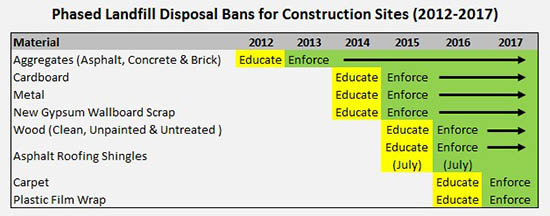|
Subscribe / Renew |
|
|
Contact Us |
|
| ► Subscribe to our Free Weekly Newsletter | |
| home | Welcome, sign in or click here to subscribe. | login |
Environment
| |
 |
February 26, 2015
Seattle is clamping down on waste from construction and demolition
United Recycling & Container

McAuliffe
|
Over 396,000 tons of construction and demolition (C&D) debris was generated in Seattle in 2013.
There are alternatives to simply treating this debris as garbage. As landfills continue to close and we become more concerned about sustainable building and reducing greenhouse gas emissions, it should not be a surprise that the city of Seattle is implementing recycling regulations to bring about change.
Recyclable waste
C&D materials consist of debris from building, remodeling or demolishing a building, as well as from heavy industrial projects like bridge replacements, airport upgrades and road construction. C&D can also include materials from industrial, manufacturing and warehouse operations.
The majority of these items fall into the categories of wood, gypsum, metal, aggregate, plastic and cardboard — materials that can be and should be recycled. In fact, the amount of debris generated during construction of a new building can be more than the occupants of that building are likely to throw out during multiple years of occupancy.
All-in-one container
Most of us are accustomed to having recycling and compost bins at our home, in addition to our garbage bin. In most cases, the recycling bin is larger than the garbage bin!
On a construction site the same can happen, except a garbage container might not even be needed. As long as 90 percent of the materials are recyclable, the rest of the debris can also be placed in the container and transported to a recycling facility.
Using one container for all of the materials is often referred to as co-mingled recycling. The recycling facility sorts the materials and extracts the recyclable materials mechanically. The goal for a recycling facility is to find end uses and markets for as many of the materials as possible, as well as stay current on new industry products and adapt quickly to achieve high recycling results.
Some materials aren’t recyclable yet because markets remain undeveloped or contamination makes them difficult to recycle — for example, carpet, insulation, asphalt shingles and painted gypsum wallboard. Some renovation or demolition job sites contain hazardous or special waste materials that need to be handled separately (lead-painted wood or plaster, asbestos floor tiles or siding, etc.).
Over the last several years, as LEED and Built Green projects have become more common, awareness regarding recycling C&D debris has increased, but not to the level that the city of Seattle is now requiring.
City requirements
The Seattle City Council adopted a goal for recycling 70 percent of construction waste by 2020 — the driving force behind the new requirements. We are confident this is achievable.
Seattle Public Utilities, tasked with helping the city to reach this goal, is doing the following:
• Certifying the recycling levels at several mixed-waste recycling facilities that receive and process C&D materials from projects in Seattle.
• Requiring that building permit-holders for each new construction, remodeling and demolition greater than 750 square feet file a waste-diversion report to show compliance with the disposal bans.
• Prohibiting disposal of specific materials (including asphalt paving, concrete, bricks, metal, cardboard, new construction gypsum scrap and clean wood). These materials must be recycled and may not be placed in containers for disposal in landfills. This is a phased approach over several years. Future bans include tear-off asphalt shingles, and carpet and plastic film wrap.
Seattle Public Utilities continues to roll out their comprehensive program to educate builders, contractors and homeowners about the requirements and their options for recycling, as well as work closely with local recyclers to ensure the materials are processed to comply with their regulations.
The first year a requirement is in place for a banned material, SPU focuses on education. After the first year, SPU can impose fines if significant amounts of recyclables are found in disposal containers or transfer station loads.
Certified facilities
As part of their effort, SPU developed a program to certify recycling activities for receiving and processing facilities to demonstrate compliance with their requirements. To earn their certification the facilities must be permitted by the local health jurisdiction, submit reports to SPU, and participate in independent testing of the residuals from sorting operations. The testing is to ensure that the materials going to a landfill do not contain a significant amount of banned materials.
Contractors who use a certified facility, either by having their materials hauled by the facility or self-hauling the materials to the facility, are considered in compliance with the SPU requirements. If the contractor uses a non-certified facility, the contractor is required to submit supporting documentation regarding their recycling efforts to demonstrate compliance.
Because SPU requires reporting to track the recycling rate at each certified facility, there is public transparency about how efficiently materials are being processed. People can make more educated decisions about where they choose to recycle their materials.
In Western Washington, there is not currently another entity besides SPU gathering and sharing the recycling rates of facilities. This level of visibility is a monumental shift for the industry.
Widespread influence
Whether or not LEED or Built Green is involved in a project, the city of Seattle and Seattle Public Utilities are demonstrating that a change in requirements will make a positive impact on construction and demolition debris-handling practices and our environment. Their regulations and implementation method facilitates education, which ultimately means fewer recyclables ending up in our landfills.
The effect of Seattle’s new regulation is likely to reach well outside of its city limits. Once contractors start recycling debris for their projects in Seattle, they will understand their options and the benefits for both them and their customers, and will continue to prioritize recycling at their other projects.
The city of Seattle took a risk to be the first entity to challenge status quo in Washington. Which corporation, developer, city or county will be next to implement a similar requirement?
Dan McAuliffe is the president of United Recycling & Container, a recycling facility and recycling hauler serving King and Snohomish counties for nearly 20 years.
Other Stories:
- Energy tools that could change the game
- Why green building has hit the wall, and what to do about it
- How to make a better business case for going green
- Making the most of your energy model
- How to treat stormwater in urban areas — like Totem Lake
- Goal of Capitol Hill EcoDistrict is to make neighborhood green
- How to convince a realist it makes sense to go green
- How do you measure the value of a green building?
- Six reasons developers should build net-zero apartments
- Federal Center South team focused on results, not ratings



